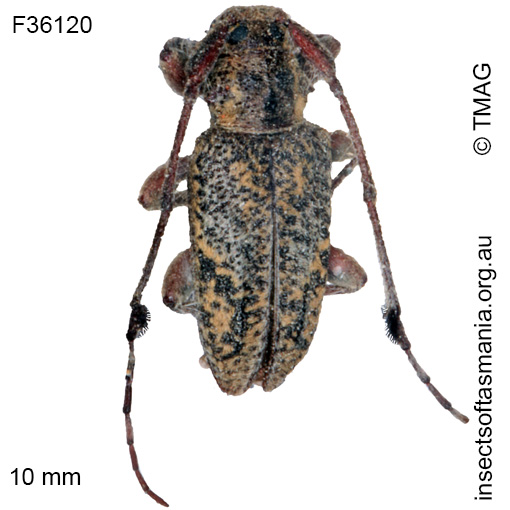
Probatodes plumula
Basis for Tasmanian occurrence
TMAG collections
Classification
Suborder: Polyphaga
Superfamily: Chrysomeloidea
Family: Cerambycidae
Subfamily: Lamiinae
Tribe: Rhodopinini
Morphology
Flightedness: winged and assumed capable of flight
Source literature on morphology and taxonomy (*primary taxonomic source, where identified):
Ślipiński, A. & Escalona, H. (2013). Australian longhorn beetles (Coleoptea: Cerambycidae), Volume 1: Introduction and Subfamily Lamiinae. CSIRO publishing, 504 pp.
Ecology
Association with dead wood or old trees: obligately saproxylic
Ecological attributes: — Acacia dealbata is a host-plant (Bashford, 1990a) — Breeds in dead or dying Acacia dealbata trees (Bashford, 1991) — Can inflict significant damage on Acacia spp. (Elliott & deLittle, 1985).
Collection method(s) for TMAG material: — At light (with use of light-trap) — Baited trapping (funnel trap) — Hand collection (substrate not specified) — Not specified — Panel trapping — Pitfall trapping — Rearing in insectary (host not documented) — Rearing in insectary from Acacia dealbata — Rearing in insectary from Acacia mearnsii — Sticky trapping on Acacia dealbata — Sticky trapping on Acacia melanoxylon.
Source ecological literature:
Bashford, R. (1990a). Tasmanian forest insects and their host plants: records from the Tasmanian Forestry Commission insect collection. Hobart: Tas. Forestry Commission, 32 pages.
Bashford, R. (1991). Wood-boring Coleoptera and associated insects reared from Acacia dealbata Link in Tasmania. Aust. Entom. Mag. 18 (3): 103-110.
Elliott, H.J. & deLittle, D.W. (1985). Insect pests of trees and timber in Tasmania. Hobart: Tas. Forestry Commission, 90 pages.
Grove, S.J. & Yaxley, B. (2005). Wildlife habitat strips and native forest ground-active beetle assemblages in plantation nodes in northeast Tasmania. Aust. J. Entom. 44 (4): 331-343.

